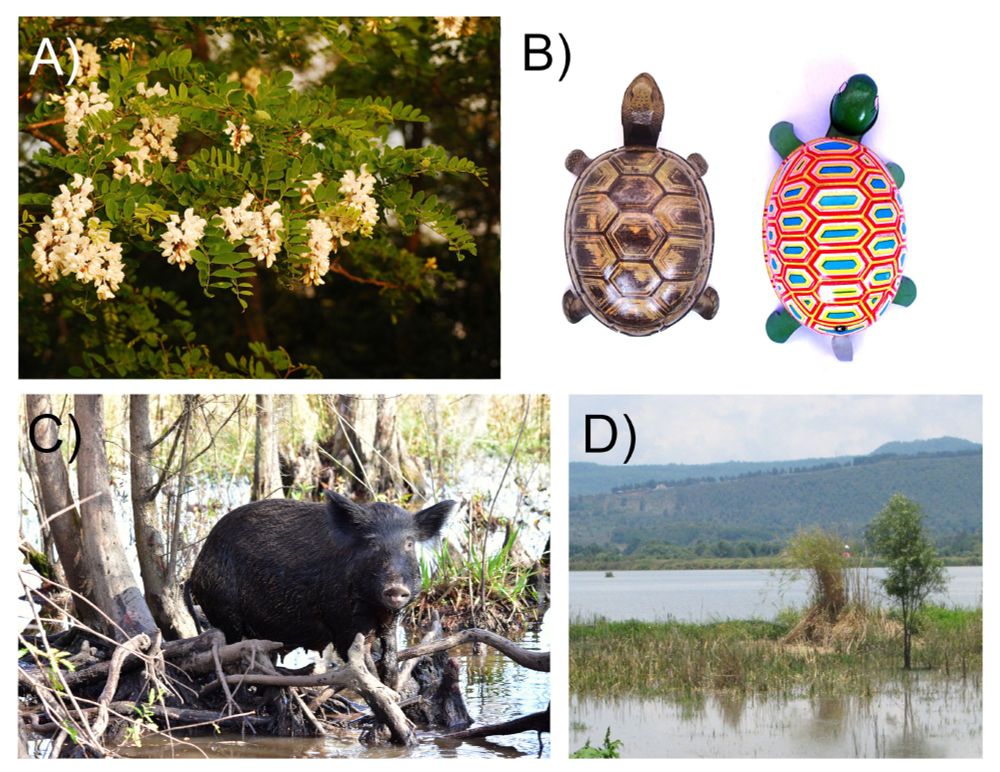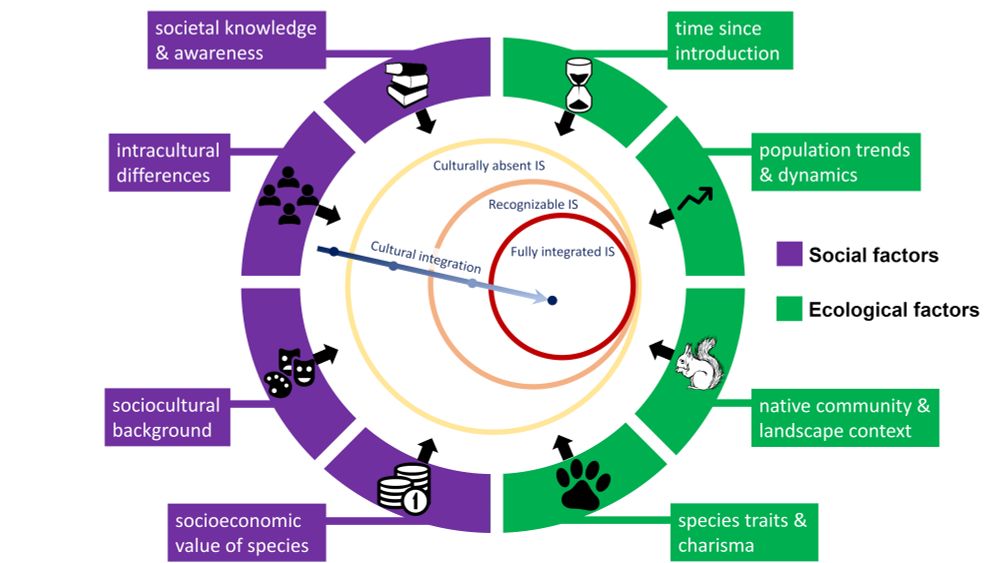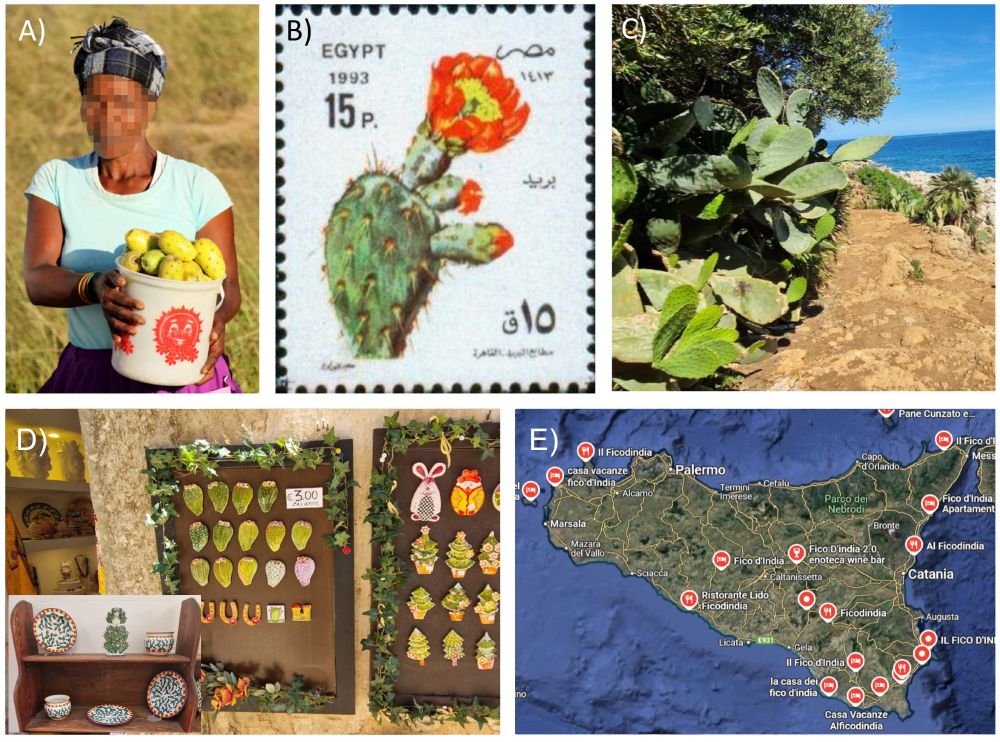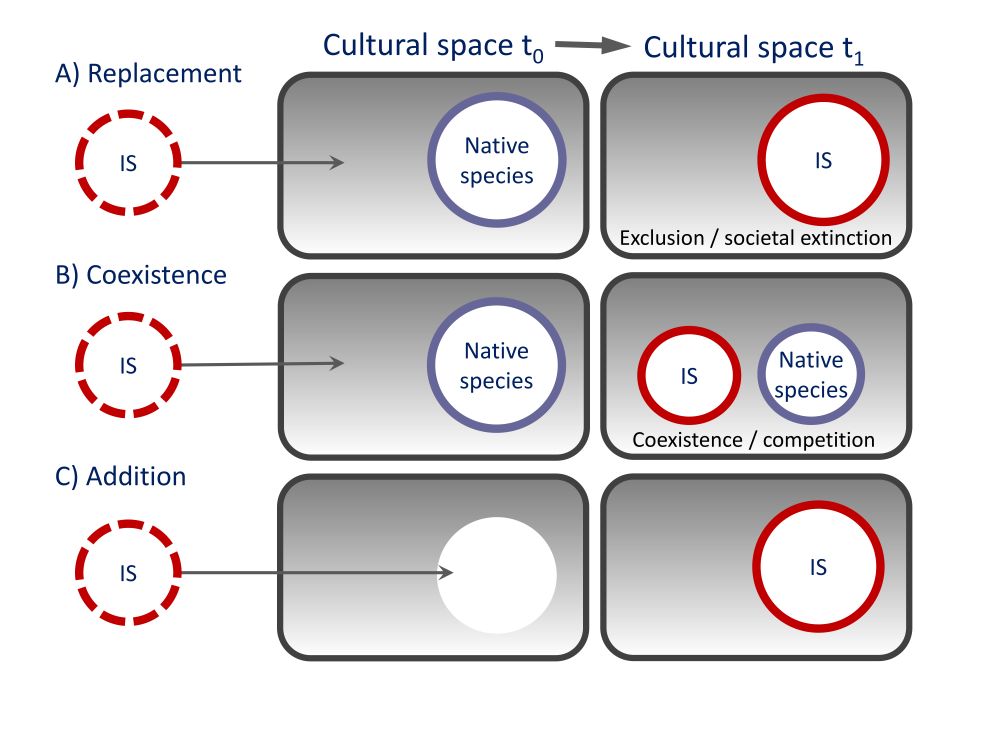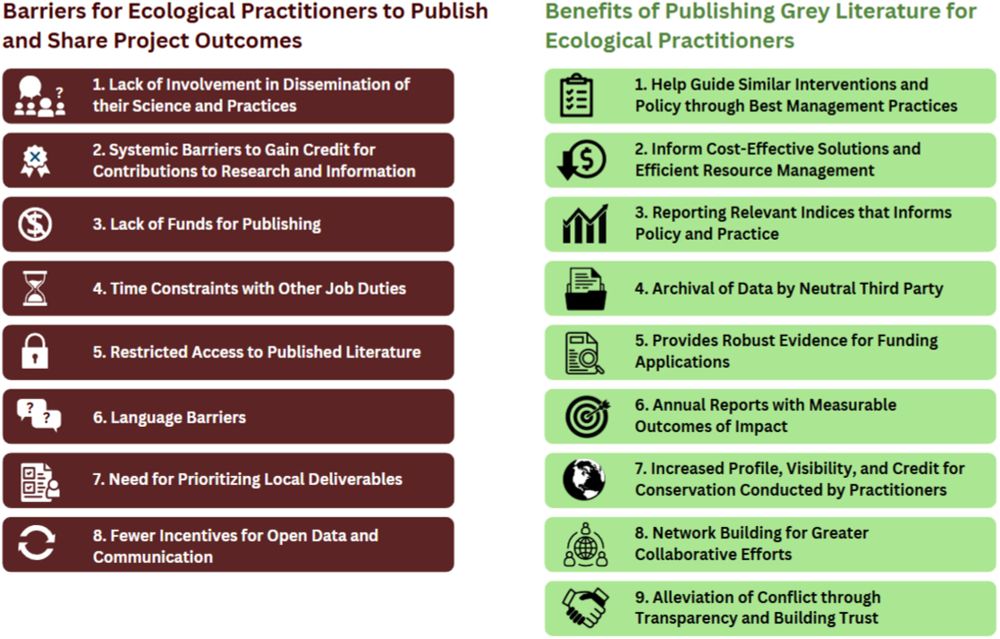

From habitats to hashtags: examining online discussions about invasive species – new paper by @scanavan.bsky.social et al. now published in #EcologyandSociety doi.org/10.5751/ES-1... #alienspecies #invasivespecies #digitaldata #socialmedia #conservationculturomics
24.10.2025 18:40 — 👍 9 🔁 7 💬 0 📌 1

🌿 CSR strategies reflect species' habitat preferences for stress and disturbance, as well as whole-plant traits, offering support for Grime’s hypothesis and highlighting its significance to understanding plant adaptation in the Anthropocene🌲
Read here: buff.ly/yFDdpAZ
16.10.2025 16:02 — 👍 18 🔁 6 💬 0 📌 0

🔎 The big picture of OneSTOP comes alive in a newly released project video!
🎞️ The video offers a short overview of OneSTOP’s objectives and methodology, as well as the project’s planned results and activities.
👉 Watch it now: www.youtube.com/watch?v=Bl6E...
#IAS #BioInvasions
09.10.2025 14:32 — 👍 4 🔁 4 💬 0 📌 1

A mind map diagram showing 5 complementary strategies for transformative change in nature conservation. The central hub reads "5 COMPLEMENTARY STRATEGIES TO BRING ABOUT TRANSFORMATIVE CHANGE" with five main branches:
"Conserve and regenerate places of value to nature and people" (TCA 28%)
"Drive systemic change in the sectors most responsible for nature's decline" (TCA 30%)
"Transform economic systems for nature and equity" (TCA 13%)
"Transform governance systems to be integrative, inclusive, accountable and adaptive" (TCA 10%)
"Shift views and values to recognize human-nature interconnectedness" (TCA 31%)
Each main branch has 4-5 specific action items numbered accordingly (e.g., 1.1-1.5, 2.1-2.4, etc.). Orange connecting lines indicate the proportion of term occurrences associated with each strategy or action, with a scale bar shown at the bottom (0-50%). The design uses teal green for main concepts and white rounded rectangles for specific actions.
🎯 5 key strategies for transformative change: From conserving vital places to shifting values.
Together these create pathways to just and sustainable futures.
IPBES #TransformativeChange Assessment: https://www.ipbes.net/transformative-change-assessment
16.10.2025 14:35 — 👍 13 🔁 6 💬 1 📌 1

A new Special Issue on aquatic invasions has just been released in NeoBiota. Read the editorial to gain an overview of all the papers: Invasions in aquatic systems.
Use this link:
neobiota.pensoft.net/article/1678...
#bioinvasions @neobiota.pensoft.net
08.10.2025 14:23 — 👍 25 🔁 14 💬 0 📌 1

Invasions Newsletter
safeguarding island havens. new research. management stories. policy updates.
📣📣 We would like to introduce the bi-annual #InvasionsNewsletter, an open-access digital magazine and a collaborative effort of individuals, networks, and organizations from around the world! You can access it here:
joom.ag/mIjd
14.05.2025 20:26 — 👍 38 🔁 19 💬 4 📌 5
The story of how this tree was introduced is so frustrating. Also because it was a "solution" brought from abroad, without really taking into account native options or what the people of the area need or want.
24.06.2025 19:01 — 👍 11 🔁 5 💬 0 📌 0
🎯 Experts from #IUCN have analysed how targeted management of #IAS can reduce extinction risks for threatened species across the #EU
🔎 Find out more at @pensoft.net / @neobiota.pensoft.net
#Bioinvasions @eualiens.bsky.social #InvasiveAlienSpecies
@cgsg.bsky.social
13.06.2025 08:21 — 👍 7 🔁 3 💬 0 📌 0


It was great to meet dear Zarah in person today! 😀 Thank you so much for your hospitality. It meant a lot to me. 🥰
@zarahpattison.bsky.social
12.06.2025 18:18 — 👍 1 🔁 0 💬 1 📌 0
#GoBelowground Morphological knowledge in plant ecology matters! @jitkaklimesova.bsky.social @ibotcz.bsky.social
04.06.2025 14:48 — 👍 1 🔁 3 💬 0 📌 0

Guidelines on how to give linguistically friendly presentations in English
We have developed guidelines on how to give linguistically friendly presentations in English for #ICCB2025 presenters. Please have a read to make your presentation inclusive. Amazing work led by @elizeyxng.bsky.social et al.
docs.google.com/document/d/1...
@iccb2025.bsky.social
#languagebarriers
03.06.2025 09:54 — 👍 24 🔁 13 💬 1 📌 3


People can read it here:
10.06.2025 21:17 — 👍 2 🔁 2 💬 0 📌 0
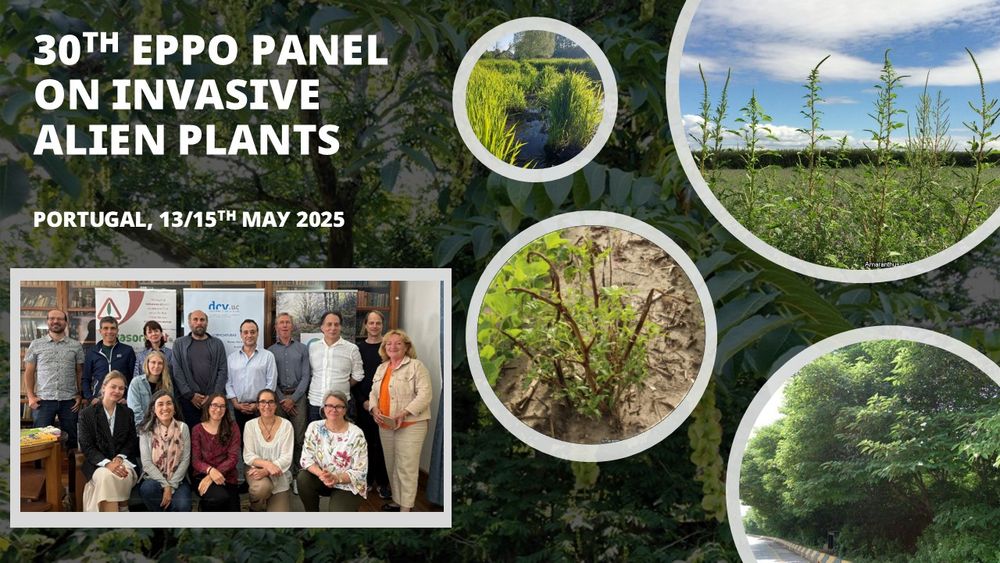
🌾The EPPO Panel on Invasive Alien Plants met at the University of Coimbra, Portugal, to advance risk assessment, prioritize 25 species, review PRA on Euphorbia davidii, explore AI tools, and boost awareness. Full report now online 👉 shorturl.at/TCP3J
20.05.2025 08:42 — 👍 5 🔁 2 💬 0 📌 0


P. aurea provided by Swen Follak

P. japonica provided by Swen Follak
Did you notice this recent publication in the EPPO Bulletin? 🪴
The EPPO Panel on Invasive Alien Plants investigated risks of invasive bamboo species to the EPPO region. These risks are summarised in Brundu et al (2025).
🔍 Read more about some of the risks in the article here: lnkd.in/eNzni5Me
11.03.2025 08:42 — 👍 3 🔁 2 💬 0 📌 0
Emerging invasive alien species and their management
This fully funded studentship explores the early identification of emerging invasive alien plants in Britain and stakeholders' awareness and management responses.
Looking for a PhD in biological invasion? Come and join us at Coventry University @coventrycawr.bsky.social this September to study emerging invasive plants. Project in collaboration with @bsbiscience.bsky.social @bsbibotany.bsky.social and linked to @onestop-project.eu.
10.03.2025 12:40 — 👍 14 🔁 12 💬 0 📌 3
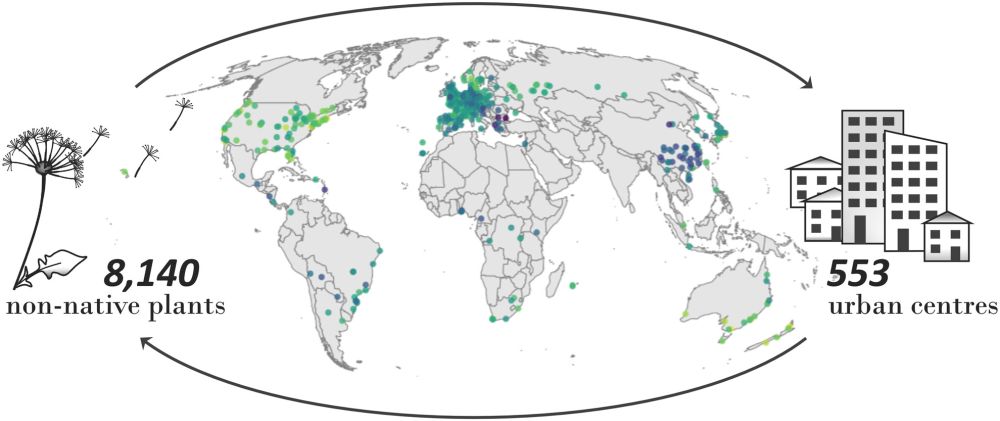
GUBIC: The global urban biological invasions compendium for plants
By integrating multiple data sources, we compiled a Global Urban Biological Invasions Compendium (GUBIC) for vascular plants representing 553 urban centres from 61 countries across every continent ex....
The global urban non-native flora is out! Seven years of work with amazing colleagues. GUBIC includes >8K species for 550 cities across the globe. bit.ly/3Fbj1wI. And the data available here zenodo.org/records/1455.... @djli.bsky.social @flamontano.bsky.social @smartenwinter.bsky.social
07.03.2025 13:05 — 👍 39 🔁 18 💬 0 📌 2
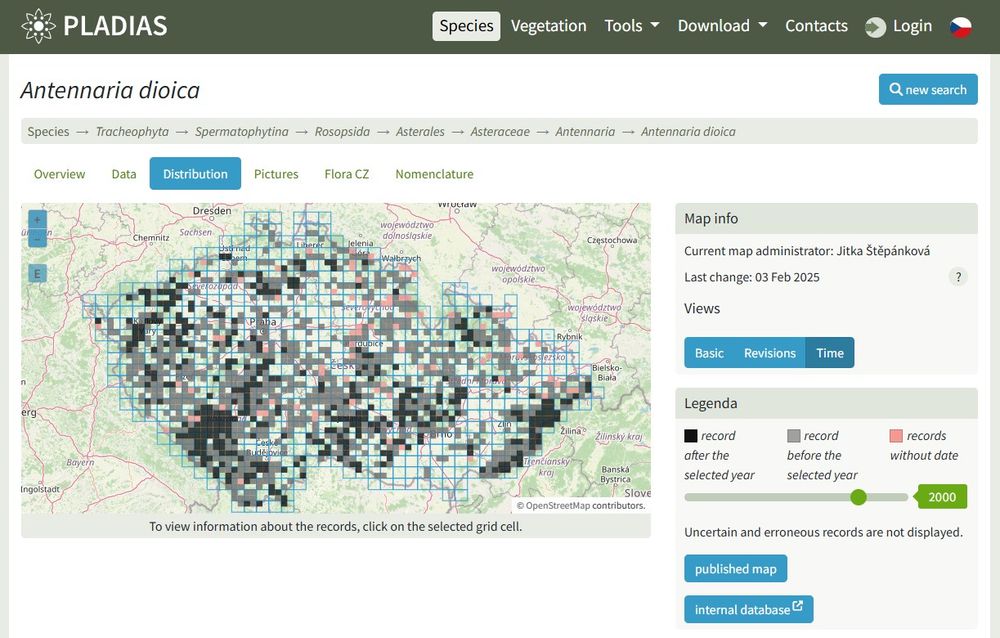
The Pladias Database of the Czech Flora and Vegetation has a new map feature that separates old and new records. This example map shows the decline of formerly common Antennaria dioica with a threshold of the year 2000:
pladias.cz/en/taxon/dis...
Thanks to Petr Novotný for programming this feature.
17.02.2025 19:41 — 👍 19 🔁 5 💬 0 📌 0
GlobalFungi
globalfungi.com
06.03.2025 13:33 — 👍 0 🔁 0 💬 0 📌 0

Visualizing the Decline of Earth’s Ecosystems
Critical ecosystems that sustain life on Earth have faced devastating declines over the past few centuries.
🌍 Nature is declining faster than ever. Since 1700:
🔹 Wetlands: -85% 🌊
🔹 Coral Reefs: -50% 🪸
🔹 Forests: -32% 🌳
🔹 Ecosystems: -47% overall
A great visualization of @ipbes.net data by Visual Capitalist and Zero Carbon Analytics ⤵️
www.visualcapitalist.com/sp/visualizi...
05.03.2025 10:47 — 👍 76 🔁 63 💬 1 📌 3

The global distribution patterns of alien vertebrate richness in mountains
Nature Communications - Among contemporary threats to mountain biodiversity, biological invasions have been understudied. This large-scale synthesis on alien vertebrates in global mountains delves...
📢Our new paper on alien vertebrates in the world's mountains is now out @naturecomms.bsky.social. Using data on 700+ spp across ~3,000 mountains we explore their distribution patterns,flows across realms, presence in protected areas, and the factors driving these trends.
🐟🐸🦎🦜🦝⛰️
👉 rdcu.be/ebidu
26.02.2025 08:31 — 👍 41 🔁 19 💬 5 📌 2
Joint Research Centre - European Commission
http://easin.jrc.ec.europa.eu
Conservation scientist @uq-cbcs.bsky.social committed to overcoming biases and barriers in conservation and science. See
http://translatesciences.com
http://kaizenconservation.com
he/him
Professor of Social-Ecological Interactions, University of Kassel & University of Göttingen. Rural landscapes | Ecosystem services | Sustainability. PersOp
www.uni-kassel.de/go/plieninger
U of Toronto Professor studying environmental change, biodiversity, and ecosystem functioning and services especially in urban systems. https://cubes-labs.com/. Editor of @aer-ese-bes.bsky.social
World leaders in the rescue and rewilding of orphaned elephants and rhinos, working across Kenya to secure a future for all wildlife.
https://links.sheldrickwildlifetrust.org
@SheldrickTrust on Instagram, Facebook, X, TikTok, Threads & YouTube
Vegetation Dynamics - Forests & Grasslands - Biological Invasions
Coordinator, IUFRO Task Force "Legacy Forest Data and Related Resources"
Editor, "Endangered Species Research" (ESR)
https://www.researchgate.net/profile/Hans-Juergen-Boehmer
Project on using online digital data to study #biologicalinvasions | funded by Czech Science Foundation #GAČR | @ivanjaric.bsky.social @pavelpipek.bsky.social @ananovoaperez.bsky.social | https://www.invaculture.net
Research + outreach in restoration and weed management in dry places. Director of the Desert Lab at Tumamoc Hill.
Invader | Ecologist | Politically opinionated scientist | I swear a lot | Rants = mine | #sentipensante | #academicmom | 🚫 No cops on campus | ✊ No one is free until we all are free 🍉
Researcher @cnrs.bsky.social #macroecology #biogeography #climatechange #biological_invasions
Lead RIVAGE project : https://urls.fr/QeAKzR
EIC Diversity&Distributions
https://celinebellard.wordpress.com
PhD
Botanist & Ecologist
With a focus on bulbs and alpines
I am looking for a postdoc position.
Biological Invasions is a peer-reviewed journal focusing on the patterns and processes of biological invasions in terrestrial, freshwater, and marine (including brackish) ecosystems. No APC!
Ecologist working on biodiversity, biological invasions (invasive species) using computer models and data stuff. Also science-policy, IPBES and indicators.
https://www.uni-giessen.de/en/faculties/f08/departments/tsz/wilke/people/hanno_seebens
Professor at @ufsc, Nature lover, biker, feminist, Brazilian tambourine player 🏳️🌈 ela/she/ella
https://leimac.sites.ufsc.br/
#invasivespecies #womeninscience #appliedecology
Invasion Ecology | Citizen Science | R || @ibotcz.bsky.social, @czechacademy.bsky.social | @depecocu.bsky.social, @sciencecharles.bsky.social, @charlesuni.cuni.cz
Plant community ecology | Botany | Vegetation science | Natural habitats | Macroecology | Biodiversity | Conservation | Global change | Scientific publishing || Professor @ Masaryk University, Brno, Czechia
Ecologist, Institute of Botany Czech Academy of Science, functional morphology of plants, plant architecture & lino cut https://klimesovajitka.wordpress.com/jitka-klimesova/
Plant Bodies https://link.springer.com/book/10.1007/978-3-031-92192-6
Go Belowground with us. It is fascinating!
Dept. Experimental and Functional Morphology at the Institute of Botany @ibotcz.bsky.social of Czech Academy of Sciences @czechacademy.bsky.social #GoBelowground #ExFuMo
Blog at plantlifebelowground.wordpress.com











